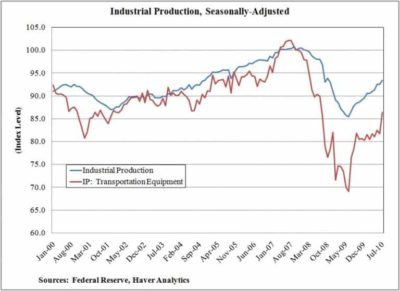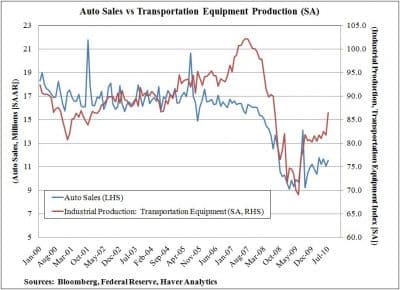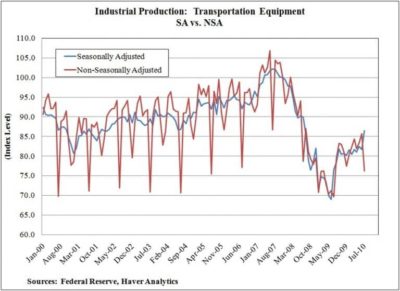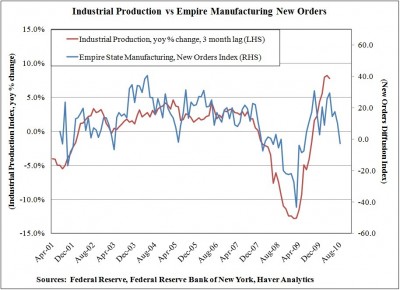The Revolution Will Not Be Seasonally Adjusted, The Sequel
The initial estimate of 2.4% annualized real GDP growth in 2Q 2010 will likely be revised lower (probably to something with a 1%-handle, depending on who you ask) in light of new data for June that was worse than the estimated (net exports, personal spending, etc). The third quarter isn’t starting off so hot either, based on some of the early data points for July. ISM manufacturing index for July ticked down and continues to roll over (though still above 50), retail sales have been relatively weak, consumer confidence has faded recently as initial jobless claims have been on the rise throughout the back half of July and into August. We’ve already discussed the weakness in July nonfarm payrolls in great detail . Consumer credit continues to decline.
That’s why today’s data on industrial production looked a little strange. Industrial Production came in much better than expected in July, up 1% month-over-month versus an expected increase of 0.5%, and appears to be continuing its unrelenting march higher. Looking through the underlying sector data, one group in particular jumped out: transportation equipment. We’ve included it in the chart below along with total industrial production.
What follows is a case study on seasonal adjustment factors.
About half of transportation equipment is auto and auto parts, and this is the segment that drove the upside in transportation equipment production in the month (the rest consists of aerospace, rail, boat, and other, all of which were muted). This seemed particularly strange, given the very moderate level of auto sales in July.
Production of transportation equipment tends to track sales, though not perfectly; aerospace and the rail/boat/other segments drove the increase in this index into late 2007 as auto sales were falling off. So why the unexpected spike in production during the month?
The Fed’s industrial production data is seasonally adjusted. You may recall how decreased auto plant shutdowns were skewing the initial claims data during July, which was widely reported . Based on the chart below, it appears that this same phenomenon is affecting the industrial production data as well.
As you can see in the chart above, the typical production decline in July is substantial before adjustments are made, and the July 2010 decline is relatively small in comparison. This may be having the effect of skewing this month’s seasonally adjusted numbers much higher, causing the noticeable spike seen above. It’s unclear how seasonal adjustments are affecting other sectors of the index, but the transportation sector is an interesting example where we have some evidence that the data is skewed.
We aren’t certain of the future path of industrial production (nobody is), but we would caution against extrapolating July’s relatively strong month-over-month results forward. Given the disappointing reading of the new orders sub-index of the Fed’s Empire Manufacturing survey, which tends to lead changes in industrial production, it seems reasonable to expect more moderate results as the effects of questionable seasonal adjustments fade.




Comments are closed.